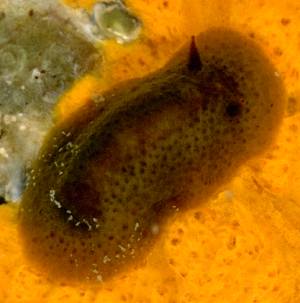
Doriopsis granulosa
Pease, 1860
Order: NUDIBRANCHIA
Suborder: DORIDINA
Family: Dorididae
DISTRIBUTION
Indo-West Pacific
PHOTO
Upper: Pointe de Babouillat, near Koumac, New Caledonia, Intertidal, coral rubble reef, shallow lagoon 13 October 1993, 7mm long alive, on orange sponge, AM C200465.
Lower: Arrawarra Headland, Coffs Harbour, New South Wales, Australia. upper intertidal under rocks on yellow-orange sponge, 16 March 1988. AM C155788. Length 28mm. [left photo showing gills] Photos: Bill Rudman
Species of Doriopsis are characterised by the arrangement of the gills in a transverse line across the back rather than in the typical dorid circle. There is a dorsal flap covering the gill opening. Doriopsis granulosa has low rounded tubercles over the mantle. It ranges in colour from a pale yellow-orange to a dark green. In yellow-green specimens the tubercles have scattered brown specks, especially on the sides, while in dark green animals the tubercles are often completely brown. Often found feeding on a yellow or orange sponge, which is probably Prianos phlox.
Specimens of Doriopsis are either deep blue, green or yellow and there has been considerable confusion in the literature concerning how many species there are in the genus. At one extreme 4 species, one each of green and blue and two of yellow have been suggested, while at the other extreme only one variably coloured species has been proposed.
Biological observations from throughout the Pacific suggest that there are at least two species, one yellow or green and one deep blue. It is also possible that the yellow New Zealand species, Doriopsis flabellifera (Cheeseman, 1881), is a third valid species. The earliest name for the yellow/green species is D. granulosa and for the blue, D. pecten. Reports from Hawaii (Kay & Young, 1969; Bertsch & Johnson,1981), Japan (Hamatani, 1961, Baba & Hamatani, 1961), and the central Pacific (Young, 1967; Johnson, 1981) show that D. pecten feeds exclusively on a deep blue sponge Terpios, and D. granulosa on a yellow or orange sponge, identified by Young (1967) as Prianos phlox de Laubenfels, 1954. The eggs of D. granulosa are reported to be yellow, while those of D. pecten are cream, and the egg ribbon of D. granulosa is about four times as wide as that of D. pecten. The green 'species' or 'form' has often been named Doriopsis viridis Pease, 1861.
Reference:
• Baba, K. & Hamatani, I., 1961. On two new species of Doriopsis (syn. Ctenodoris) from Japan (Nudibranchia - Dorididae). Publications of the Seto Marine Biological Laboratory, 9: 63-65.
• Bertsch, H. & Johnson, S., 1981. Hawaiian Nudibranchs. Honolulu: Oriental Publishing Co.
• Hamatani, I., 1961. Notes on veligers of Japanese opisthobranchs (4). Publications of the Seto Marine Biological Laboratory, 9(2): 353-361.
• Johnson, S., 1981. Blue camouflage in a nudibranch. Hawaiian Shell News, 29(6): 14.
• Kay, E.A. & Young, D.K., 1969. The Doridacea (Opisthobranchia: Mollusca) of the Hawaiian Islands. Pacific Science, 23: 172-231.
• Pease, W.H. (1860). Descriptions of new species of mollusca from the Sandwich Islands. Proceedings of the Zoological Society of London, 28: 18-37.
• Young, D.K., 1967. New records of Nudibranchia from the Central and West-Central Pacific with a description of a new species. The Veliger, 10: 159-173
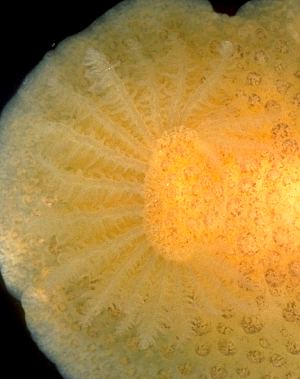
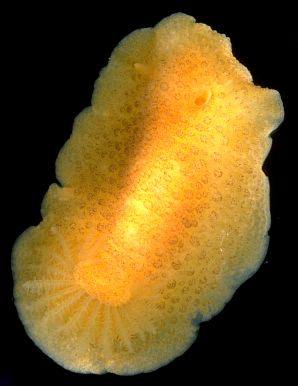
Rudman, W.B., 2003 (March 7) Doriopsis granulosa Pease, 1860. [In] Sea Slug Forum. Australian Museum, Sydney. Available from http://www.seaslugforum.net/find/dorigran
Related messages
Re: Doriopsis pecten and egg ribbon from Japan
October 13, 2008
From: Gary Cobb
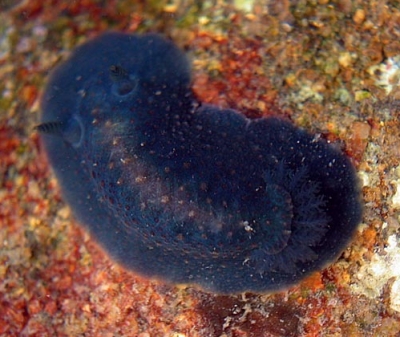
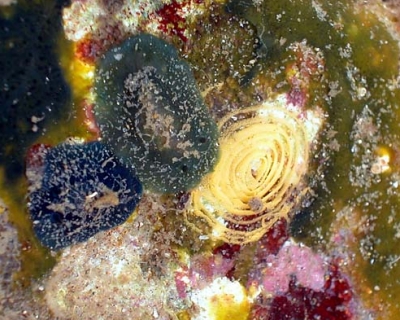
Concerning message #9368:
Hi Bill and everyone!
Well the saga begins! Here are some photos of Doriopsis pecten found here in our 'backyard'. The egg mass from Japan does not look anything like the ones we find here. They are always golden-yellow. David Mullins and I have observed quite a few animals on or near these coloured egg masses. The animals themselves have been found coloured brilliant blue to green.
Locality: Mooloolaba, Sunshine Coast, Intertidal-20 m, Queensland, Australia, Pacific Ocean, 02 October 2008, Subtidal and Intertidal. Length: 8-15 mm. Photographer: Gary Cobb.
Hummm...
Cheers Gary
gary@nudibranch.com.au
Cobb, G.C., 2008 (Oct 13) Re: Doriopsis pecten and egg ribbon from Japan. [Message in] Sea Slug Forum. Australian Museum, Sydney. Available from http://www.seaslugforum.net/find/21934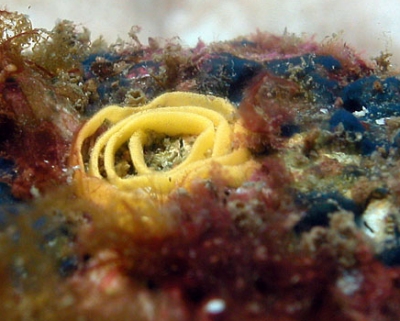
Thanks Gary,
This is a nice example of why knowing something about a species' food and egg ribbons is just as valuable as lots of anatomy. If you look at the Fact Sheets on Doriopsis granulosa and D. pecten and my comments in many of the attached messages, you will see I think there are two widespread speices in the tropical Indo-West Pacific. One of these is the dark blue D. pecten which apprears to feed exclusively on a dark blue sponge of the genus Terpios. Its egg ribbon, as illustrated in Nishina Masayoshi's recent message [#9368] is white with a frilly edge, and quite small and delicate. The other species, D. granulosa, is usually considered to be yellow, but as I discuss on the Forum [#9351], I am pretty sure it is variable in colour sometimes being a dark green. It feeds on another sponge, which has been indentified as Prianos phlox. This sponge is usually yellow or yellowish orange, but I suspect from your middle photo can also be greenish yellow. The egg ribbon of this species [#9329] is much larger, sturdier, and yellow.
Both these sponges can be found in close proximity to each other. My interpretation of your photos is that the blue one in the upper photo is D. pecten, but the dark greenish one in the middle photo is D. granulosa. Both yellow egg ribbons appear to be those of D. granulosa, but I can't get any feel for the height of the ribbon in the middle photo. In the middle photo, the dark blue sponge on the left is Terpios, while the greenish sponge on the right is almost certainly what I am calling Prianos phlox. It is possible the blue animal in your upper photo is also D. granulosa but I think it would be a bit unfair on us if bit D. granulosa also has a colour form identical to that of D. pecten.
I guess what you should watch out for is the white frilly ribbon of D. pecten, and whether blue animals are always on the blue sponge while all other coloured animals - even dark green - are on yellow to yellow-green sponges.
Best wishes,
Bill Rudman
The gill of Doriopsis
March 7, 2003
From: Bill Rudman
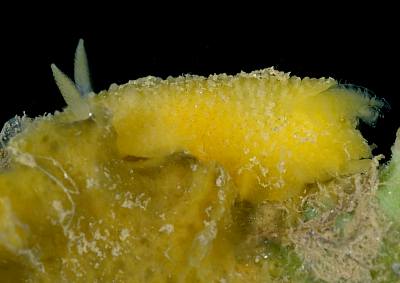
Here are some photos to show the gill in Doriopsis granulosa. Species of Doriopsis differ from most dorids in having the gills arranged in a posteriorly facing, horizontal fan. There is a flap of mantle which hangs over, and protects the gill opening. See D. pecten Fact Sheet for a similar photo of its gill. Another name for the genus is 'Ctenodoris' which is from the Latin word for a comb, which refers to the comb-like appearance of the gills. The name pecten also is derived from the same Latin word.
Photos: Upper Right, Lower Left: Paagoumène, near Koumac, New Caledonia, 20°29.2'S, 164°10.2'E, intertidal, 12 October 1993, 18mm long alive, AM C200452.
Lower Right: Arrawarra Headland, Coffs Harbour, NSW, Australia, upper intertidal, 16 March 1988, C155788. Length approx 28mm. Photos: Bill Rudman
Best wishes,
Bill Rudman
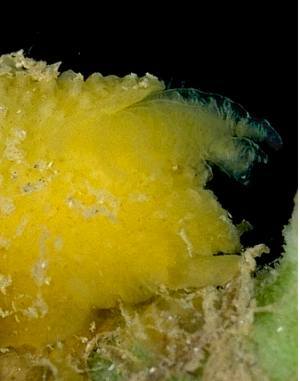

Doriopsis granulosa - mantle tubercles
March 7, 2003
From: Bill Rudman
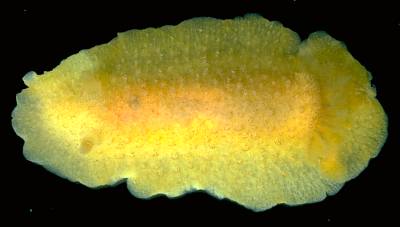
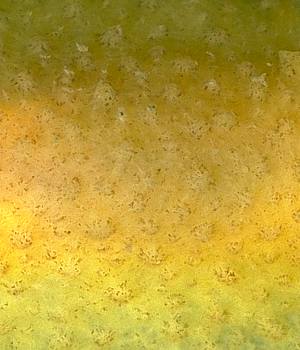
This specimen of Doriopsis granulosa from New Caledonia, shows the shape and colour of the mantle tubercles quite clearly. Note the brown specks which are concentrated on the sides of each tubercle.
Photo: Pointe de Pandop, near Koumac, New Caledonia, 20°35'S, 164°15.5'E, intertidal, hard substrate, algae, 14 October 1993, 30mm long alive, AM C200475. Photo: Bill Rudman.
Best wishes,
Bill Rudman
Doriopsis granulosa from eastern Australia
March 7, 2003
From: Bill Rudman
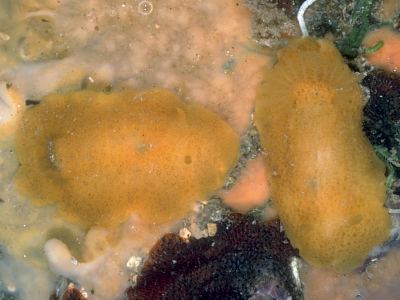
Rachel Przeslawski's message has shamed me into preparing some information on Doriopsis pecten and D. granulosa. I note that I promised to do this 3 years ago! I am therefore posting simultaneously, a number of messages showing colour range, food sponge and gill shape of both species. Any other information, including egg ribbons, would be very welcome.
These specimens of Doriopsis granulosa are from northern New South Wales. The dorsum was yellow, with low rounded tubercles. These tubercles had scattered brownish specks, especially around the edge, which gave them a brownish outline.
Photo: Arrawarra Headland, Coffs Hbr, NSW, Australia. Upper intertidal under rocks, on sponge which ranged in colour from yellow to orange. 16 Mar 1988. AM C155788. A number of specimens were found, ranging in length from 20-28mm. Photos: Bill Rudman.
Best wishes,
Bill Rudman
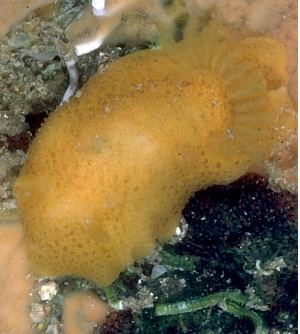

Dark blue-green Doriopsis granulosa
March 7, 2003
From: Bill Rudman
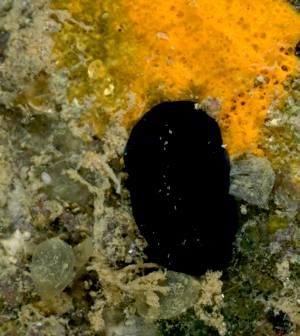
This very dark blue-green animal was found on this orange sponge, which it appears to have been eating. The sponge was partly eaten and the nudibranch stayed on it for some hours in an aquarium, ignoring a small colony of the blue sponge Terpios, on the same rock. Terpios is the preferred food of the blue Doriopsis pecten. No radula differences could be found between the different coloured specimens. Without further evidence, and since this orange sponge is the preferred food of Doriopsis granulosa, I can only assume that it is a very dark form of that species.
Photo: Paagoumène, near Koumac, New Caledonia, 20°29.2'S, 164°10.2'E, Intertidal, coral platform with coral blocks, sea grass beds, 12 October 1993, 5mm long alive, AM C200451. Photo: Bill Rudman
Best wishes,
Bill Rudman
Brown Doriopsis granulosa from New Caledonia
March 7, 2003
From: Bill Rudman
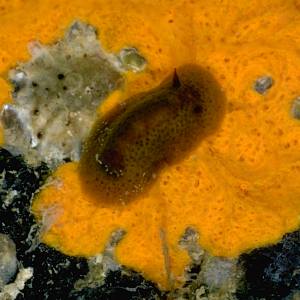

Here is a greenish brown Doriopsis which previously would have been identified as D. viridis. I assume from its feeding on this orange sponge that it is a colour form of Doriopsis granulosa.
Photo: Pointe de Babouillat, near Koumac, New Caledonia, 20°22.4'S, 164°6.8'E, Intertidal, coral rubble reef, shallow lagoon 13 October 1993, 7mm long alive, on orange sponge, AM C200465. Photos: Bill Rudman.
Cheers,
Bill Rudman
Doriopsis granulosa - egg ribbon
March 5, 2003
From: Rachel Przeslawski
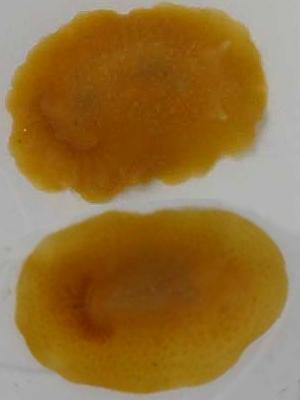
Hi Bill,
While at Lake Illawarra, New South Wales, Australia, recently, I found these two little slugs under a boulder. I brought them back to the lab in the hopes that they'd lay, and sure enough after one night I had this nice egg mass on an airstone. I'm pretty sure these are Dendrodoris carneloa due to the hard mantle and small pustules, but I thought I'd better doublecheck with you.
The egg ribbon looks similar to many other nudibranchs, with the exception that the egg-free rind that I often see on the edges of ribbons was completely absent in this species.
Thanks!
Rachel Przeslawski
rachelp@uow.edu.au
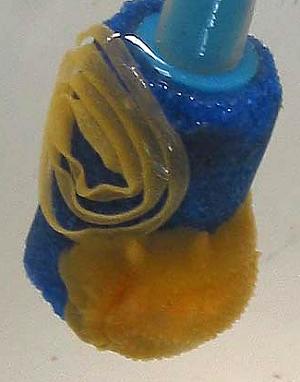
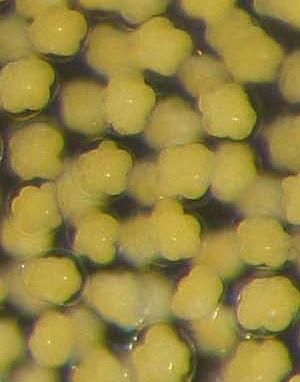
Dear Rachel,
Although it looks quite like D. carneola this is Doriopsis granulosa. Although it not too clear in your photos, if you look carefully you will see the gills stick out horizontally in a fan-shaped arrangement, with a rounded flap of mantle lying over the top of the gill pocket. This arrangement is only found in species of the genus Doriopsis. I see I promised a year or more ago to prepare pages on this species and Doriopsis pecten. I'll see what I can do.
Cheers,
Bill Rudman
Doriopsis granulosa from Kerama Islands
April 27, 1999
From: Rie Nakano
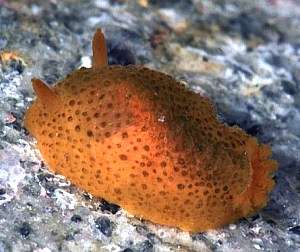
Dear Bill,
Here is another of Mr Atsushi Ono 's images from Kerama Island, near Okinawa which you offered to identify for us.
It was collected on the coral reef, Depth: 5m, Length: 13mm.
Rie Nakano
rie@street.ne.jp
Nakano, R., 1999 (Apr 27) Doriopsis granulosa from Kerama Islands. [Message in] Sea Slug Forum. Australian Museum, Sydney. Available from http://www.seaslugforum.net/find/815Dear Rie,
This is Doriopsis granulosa Pease, 1860. The species of this genus can be recognised by the arrangement of the gills in a horizontal line rather than a circle. Another name for the genus is 'Ctenododoris' which is from the latin word for a comb, which refers to the comb-like appearance of the gills.
Best wishes,
Bill Rudman.
